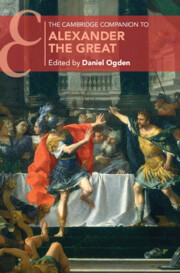Book contents
- The Cambridge Companion to Alexander the Great
- Cambridge Companions to the Ancient World
- The Cambridge Companion to Alexander the Great
- Copyright page
- Dedication
- Contents
- Figures
- Tables
- Maps
- Abbreviations
- Notes on Contributors
- Acknowledgements
- Introduction
- Part I Alexander’s Life and Career
- Part II Contexts
- Part III The Historical and Biographical Tradition
- Part IV The Ancient World’s Memory of Alexander
- 26 The Successors and the Image of Alexander
- 27 Alexander and The Roman Emperors
- 28 The Alexander Romance
- 29 Alexander in Jewish and Early Christian Literature
- 30 Alexander in Ancient Art
- Alexander’s Timeline 356–321 BC
- References
- Index
- Cambridge Companions to the Ancient World
30 - Alexander in Ancient Art
from Part IV - The Ancient World’s Memory of Alexander
Published online by Cambridge University Press: 04 January 2024
- The Cambridge Companion to Alexander the Great
- Cambridge Companions to the Ancient World
- The Cambridge Companion to Alexander the Great
- Copyright page
- Dedication
- Contents
- Figures
- Tables
- Maps
- Abbreviations
- Notes on Contributors
- Acknowledgements
- Introduction
- Part I Alexander’s Life and Career
- Part II Contexts
- Part III The Historical and Biographical Tradition
- Part IV The Ancient World’s Memory of Alexander
- 26 The Successors and the Image of Alexander
- 27 Alexander and The Roman Emperors
- 28 The Alexander Romance
- 29 Alexander in Jewish and Early Christian Literature
- 30 Alexander in Ancient Art
- Alexander’s Timeline 356–321 BC
- References
- Index
- Cambridge Companions to the Ancient World
Summary
The images of Alexander deriving from his own lifetime fall into two main categories: on the one hand, representations without attributes, which are more or less what we would now term ‘portraits’; and on the other hand, representations with attributes, which have an allegorical function, their purpose being to give out a message about Alexander, to tell a story about him, rather than merely to convey his likeness. Images of Alexander in sculpture tended towards ‘realism’, while images of him in painting and glyptics tended towards allegorization. The attributes given to Alexander in art during his own lifetime are restricted in their epistemological content, being predominantly of a military sort, such as a spear or armour. But a much richer repertoire of attributes emerges for him in the posthumous representations of the king generated by and for his successors in the Hellenistic age. Above all, these allowed for his direct association with the divine: the aegis associated him with Zeus and Athena; ram’s horns with Zeus-Ammon; goat’s horns with Pan; bull’s horns with Dionysus; the lion-scalp with Heracles; the elephant-scalp with Dionysus; and the radiate crown with Apollo-Helios.
Keywords
- Type
- Chapter
- Information
- The Cambridge Companion to Alexander the Great , pp. 488 - 517Publisher: Cambridge University PressPrint publication year: 2024



